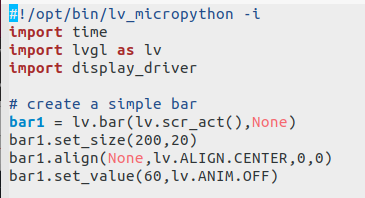LVGL on the T-Watch 2020
Introduction
Since the t-watch 2020 has a rather high resolution screen in combination with a touch panel, it is possible to run Graphical User Interfaces (GUIs) right on the watch. A popular GUI library is lvgl- https://github.com/OPHoperHPO/lilygo-ttgo-twatch-2020-micropython/blob/master/README.md

- https://github.com/lvgl/lv_micropython

Software available for the T-Watch
The factory firmware is https://github.com/sharandac/My-TTGO-Watch.Running lv_micropython of the t-watch
MicroPython compiles for the t-watch "out of the box". In order to get a version with lvgl and all drivers and their MicroPython language binding to work is another story. Therefore the repository mentioned above. The MicroPython language binding contains lvgl initialization code in the module display_driver.py, which makes it very easy to create and run simple lvgl programs on the t-watch. display_driver.py checks on which hardware it is running- SDL driver for the uniy port simulating a display
- ili9341, used e.g. on the LoLin TFT-2.4" display
- or the t-watch

 --
-- Comments
| I | Attachment | History | Action | Size | Date | Who | Comment |
|---|---|---|---|---|---|---|---|
| |
lvgl_bar.png | r1 | manage | 4.2 K | 2021-01-08 - 11:17 | UliRaich | |
| |
lvgl_bar_code.png | r1 | manage | 22.0 K | 2021-01-08 - 11:17 | UliRaich |
Ideas, requests, problems regarding TWiki? Send feedback



